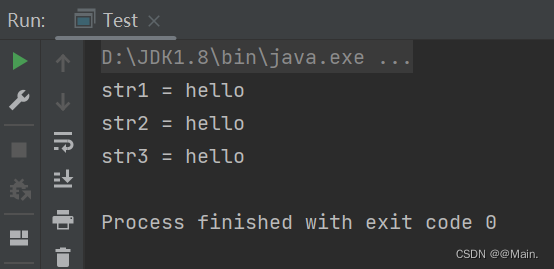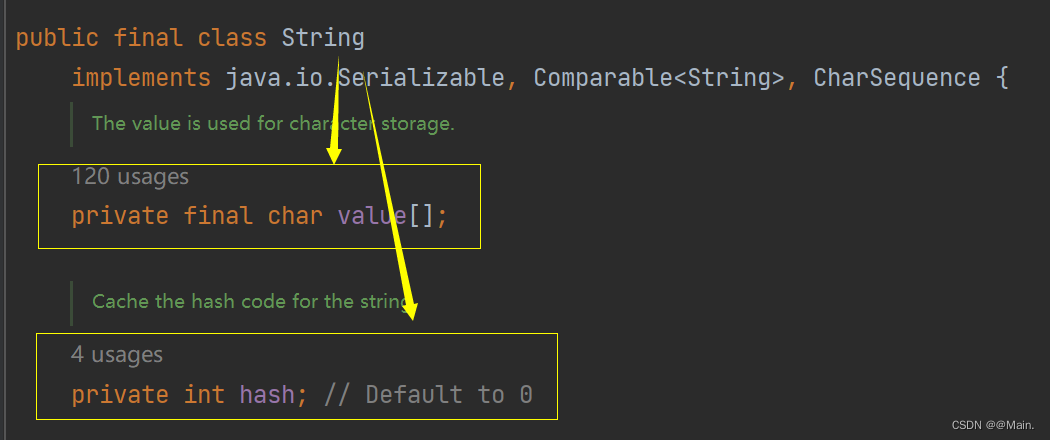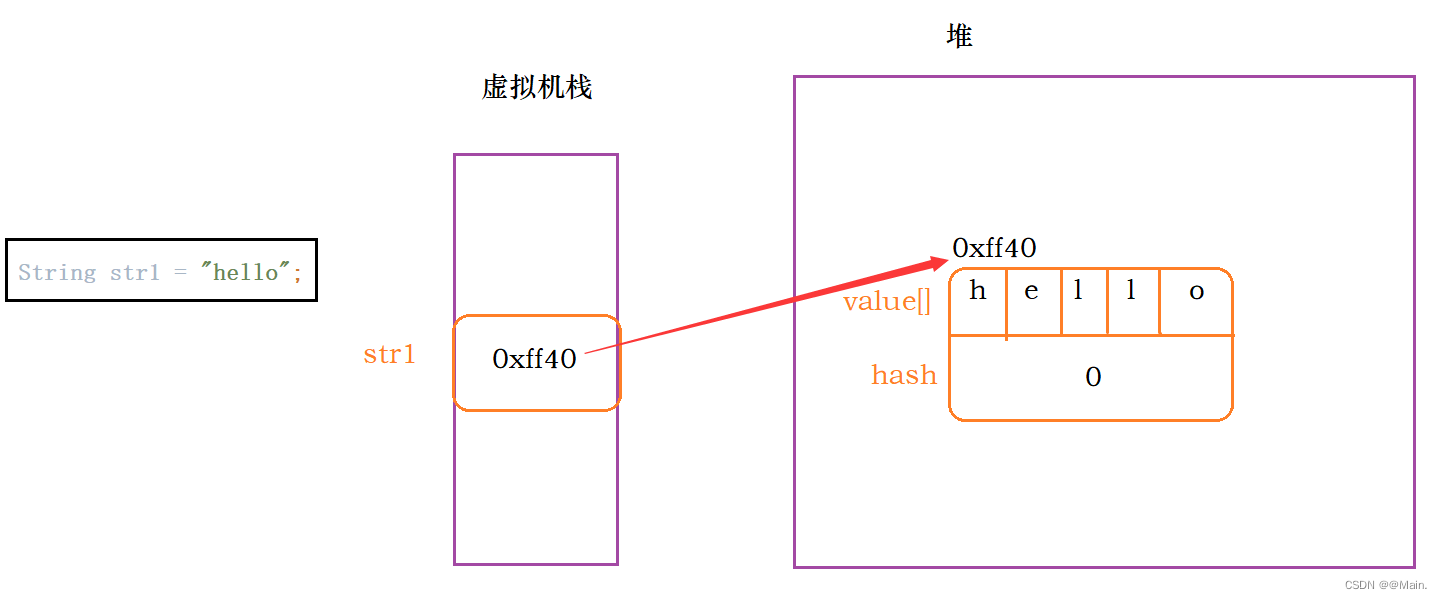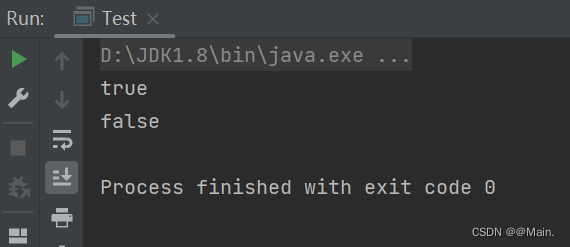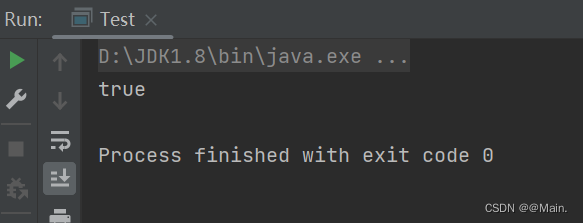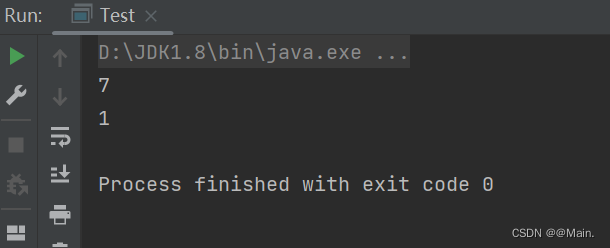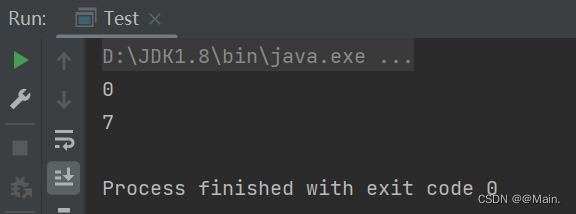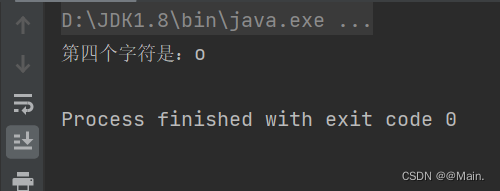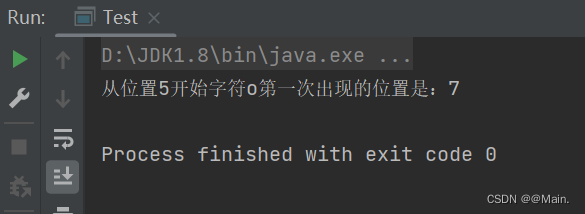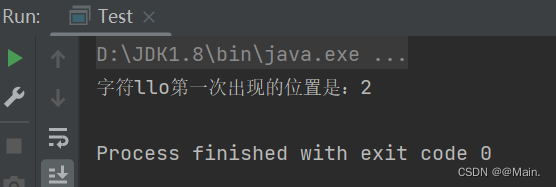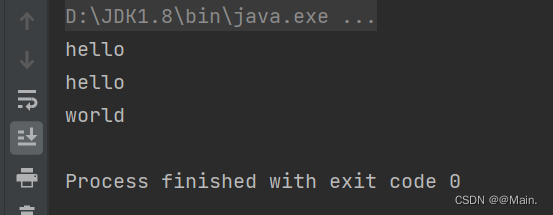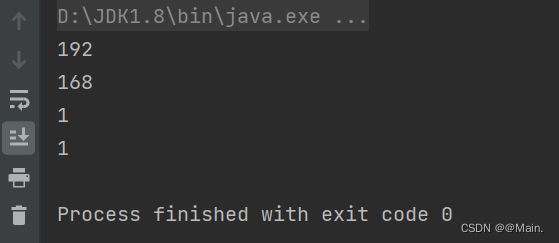
本篇文章清楚总结了一些常用String类中包含的方法,熟练运用后即可在题海中节省大量时间

字符串构造
赋值字符串构造
//通过字符串构造 String str1 = "hello"; System.out.println("str1 = " + str1);
通过new对象构造
//通过new对象构造 String str2 = new String("hello"); System.out.println("str2 = " + str2);
通过字符数组构造
//通过字符数组构造 char[] arr = {'h','e','l','l','o'}; String str3 = new String(arr); System.out.println("str3 = " + str3);
字符串数组本质
因为String属于引用类型,所以str内存储的并不是字符串内容本身。
我们进入String源码可以看到str数组内部存储的是对象的地址,字符串内容其实是存在**字符数组value[ ]**中的:
调试起来看:
这是它的简化内存布局图:
字符串长度
求字符串长度
返回值:字符串或数组长度
String str1 = "hello"; System.out.println(str1.length());
判断字符串长度是否为0
为0返回ture;
不为0返回false
String str1 = "hello"; System.out.println(str1.isEmpty());
String对象比较
==的使用
内置类型:比较两个变量的值是否相等;
引用类型:比较的是引用的地址.
返回值:相同返回true,否则返回false.
public static void main(String[] args) { int a = 10; int b = 10; System.out.println(a == b); String s1 = new String("hello"); String s2 = new String("hello"); System.out.println(s1 == s2); }
具体的在下文中字符串常量池中。
boolean equeal(Object anObject) 方法:按照字典序比较是否相同
返回值:相同返回true,否则返回false.
我们知道所有类都继承着Object这个父类,虽然Object中的equal方法是按照==来比较的,但是在
String类中重写了equal方法,这样就可以按照字面值来比较了:
public static void main(String[] args) { String s1 = new String("hello"); String s2 = new String("hello"); System.out.println(s1.equals(s2)); }
int compareTo(String s) 方法:按照字典序比较大小
通过comparaTo源码可以看到:
返回值是int类型:
如果有不同的字符,返回字符的ASCII值差值;
如果没有不同的字符,返回长度的差值.
- 使用方法:*
public static void main(String[] args) { String s1 = new String("hello"); //h:104 String s2 = new String("aello"); //a:97 int ret1 = s1.compareTo(s2); //104 - 97 = 7 System.out.println(ret1); String s3 = new String("abc"); //长度为3 String s4 = new String("ab"); //长度为2 int ret2 = s3.compareTo(s4); // 3 - 2 = 1 System.out.println(ret2); }
boolean equalsIgnoreCase(Object anObject) 方法:忽略大小写比较是否相等
返回值:与equal一样
public static void main(String[] args) { String s1 = new String("hello"); String s2 = new String("Hello"); System.out.println(s1.equalsIgnoreCase(s2)); String s3 = new String("hello"); String s4 = new String("aello"); System.out.println(s3.equalsIgnoreCase(s4)); }
int compareToIgnoreCase(String s) 方法:忽略大小比较字符串大小
返回值:与compareTo一样
public static void main(String[] args) { String s1 = new String("hello"); String s2 = new String("Hello"); System.out.println(s1.compareToIgnoreCase(s2)); String s3 = new String("hello"); String s4 = new String("aello"); System.out.println(s3.compareToIgnoreCase(s4)); }
字符串查找
char charAt(int index) 方法:得到指定位置的字符
public static void main(String[] args) { String s1 = "hello world"; char ch = s1.charAt(4); System.out.println("第四个字符是:" + ch); }
如果指定位置为负或者越界:抛出 IndexOutOfBoundsException异常。
int indexOf(int ch) 方法:得到指定字符首次出现的位置
返回值:存在则返回第一次出现的位置;否则返回-1;
public static void main(String[] args) { String s1 = "hello world"; int ch = s1.indexOf('l'); System.out.println("字符o第一次出现的位置是:" + ch); }
int indexOf(int ch, int fromIndex) 方法:从fromIndex位置开始找字符ch第一次出现的位置
返回值:存在则返回在整个字符串中的位置;否则返回-1;
public static void main(String[] args) { String s1 = "hello world"; int ch = s1.indexOf('o',5);//位置5处是空格 System.out.println("从位置5开始字符o第一次出现的位置是:" + ch); }
int indexOf(String s) 方法:得到字符串s第一次出现的位置
返回值:存在返回首字符第一次出现的位置;否则返回-1;
public static void main(String[] args) { String s1 = "hello world"; int ch = s1.indexOf("llo"); System.out.println("字符llo第一次出现的位置是:" + ch); }
int indexOf(String s, int fromIndex) 方法:得到字符串s从fromIndex位置开始第一次出现的位置
返回值:存在则返回在整个字符串中的位置;否则返回-1;
public static void main(String[] args) { String s1 = "hello hello world"; int ch = s1.indexOf("llo",4); System.out.println("从位置4开始字符llo第一次出现的位置是:" + ch); }
int lastIndexOf(int ch) 方法:从后往前找,得到字符ch第一次出现的位置
返回值:存在则返回从后往前第一次出现的位置;否则返回-1
public static void main(String[] args) { String s1 = "hello hello world"; //第一个o在4位置 第二个o在10位置 第三个o在13位置 int ch = s1.lastIndexOf('o'); System.out.println("从后往前找,字符o第一次出现的位置是:" + ch); }
int lastIndexOf(int ch, int fromIndex) 方法:从fromIndex位置开始,从后往前找,得到ch第一次的位置
返回值:存在则返回所在位置;否则返回-1
public static void main(String[] args) { String s1 = "hello hello world"; //第一个o在4位置 第二个o在10位置 第三个o在13位置 int ch = s1.lastIndexOf('o',12); System.out.println("从12位置起,从后往前找,字符o第一次出现的位置是:" + ch); }
int lastIndexOf(String s) 方法:从后往前找,得到字符串s在整个字符串中第一次出现的位置
返回值:找到返回s的首元素在整个字符串中第一次出现的位置;否则返回-1
public static void main(String[] args) { String s1 = "hello hello world"; int ch = s1.lastIndexOf("llo"); System.out.println("从后往前找,字符串llo第一次出现的位置是:" + ch); }
int lastIndexOf(String s, int fromIndex) 方法:从fromIndex位置开始,从后往前找,得到字符串第一次的位置
返回值:同上
public static void main(String[] args) { String s1 = "hello hello world"; int ch = s1.lastIndexOf("llo",7); System.out.println("从位置7起,从后往前找,字符串llo第一次出现的位置是:" + ch); }
转化
其他类型转为字符串:
数字转字符串
String s1 = String.valueOf(100); String s2 = String.valueOf(3.1415);布尔类型转字符串
String s3 = String.valueOf(true); String s4 = String.valueOf(false);实例化对象转字符串
class Student{ public String name; public int age; public Student(String name, int age) { this.name = name; this.age = age; } public static void main(String[] args) { String s1 = String.valueOf(new Student("张三",18)); } }
字符串转为其他类型:
字符串转数字
int num1 = Integer.parseInt("123321"); double num2 = Double.parseDouble("3.1415926");字符串转布尔类型
boolean flag1 = Boolean.parseBoolean("true"); boolean flag2 = Boolean.parseBoolean("false");
字符串与数组之间转化:
字符串转数组
public static void main(String[] args) { String s1 = "hello"; char[] ch = s1.toCharArray(); for (int i = 0; i < ch.length; i++) { System.out.print(ch[i]); } }
数组转字符串
public static void main(String[] args) { char[] ch = {'h','e','l','l','o'}; String s1 = new String(ch); System.out.println(s1); }
大小写转化:
小写转大写
public static void main(String[] args) { String s1 = "hello"; System.out.println(s1.toUpperCase()); }
小写转大写
public static void main(String[] args) { String s1 = "HELLO"; System.out.println(s1.toLowerCase()); }
格式化:
public static void main(String[] args) { String s = String.format("%d - %d - %d",2022,8,12); System.out.println(s); }
字符串替换
Sting replaceAll() 方法:用给定字符串替换所有指定的字符串
public static void main(String[] args) {
String s1 = "hello hello World";
String s2 = s1.replaceAll("ll","a");
System.out.println(s2);
}

String replaceFirst() 方法:只替换原字符串中第一次出现的指定字符串
public static void main(String[] args) {
String s1 = "hello hello World";
String s2 = s1.replaceFirst("ll","a");
System.out.println(s2);
}

字符串拆分
可以将字符串按照字符串内已有符号进行分割;
将字符串全部拆分
返回值:数组
public static void main(String[] args) { String s1 = "hello@hello@world"; String[] s2 = s1.split("@"); for (String s: s2) { System.out.println(s); } }
将字符串拆分成指定组
返回值:数组
public static void main(String[] args) { String s1 = "hello@hello@world"; String[] s2 = s1.split("@",2); for (String s: s2) { System.out.println(s); } }
以下是特殊的:
以 . 号拆分
需要加两个转义字符:
public static void main(String[] args) { String s1 = "192.168.1.1"; String[] s2 = s1.split("\\."); for (String s: s2) { System.out.println(s); } }
以 \ 号拆分
因为\表示一个\,所以需要在前面再加两个\:
public static void main(String[] args) { String s1 = "2022\\08\\12"; System.out.println("原来是:" + s1); String[] s2 = s1.split("\\\\"); System.out.println("现在是:"); for (String s: s2) { System.out.println(s); } }
多次拆分(分步拆分)
public static void main(String[] args) { String s1 = "mp.csdn.net/2022"; System.out.println("原来是:" + s1); System.out.println("现在是:"); String[] s2 = s1.split("/"); for (String s: s2) { String[] ss = s.split("\\."); for (String temp: ss) { System.out.println(temp); } } }
字符串截取
从一个完整的字符串中截取部分;
从指定位置截取到结尾
返回值:字符串
public static void main(String[] args) { String s1 = "hello world"; String s2 = s1.substring(6); System.out.println(s2); }
截取指定长度
长度是(起始位置,终点位置):左闭右开
public static void main(String[] args) { String s1 = "hello world"; String s2 = s1.substring(6,10); System.out.println(s2); String s3 = s1.substring(6,11); System.out.println(s3); }
去掉字符串左右空格,保留中间空格
trim() 可以字符串开头和结尾的空格、制表符、回车等;
public static void main(String[] args) { String s1 = " hello world \t " + " "; String s2 = " " + " tomorrow "; System.out.println( "[" + s1.trim() + s2.trim() + "]"); }
版权归原作者 @Main. 所有, 如有侵权,请联系我们删除。
